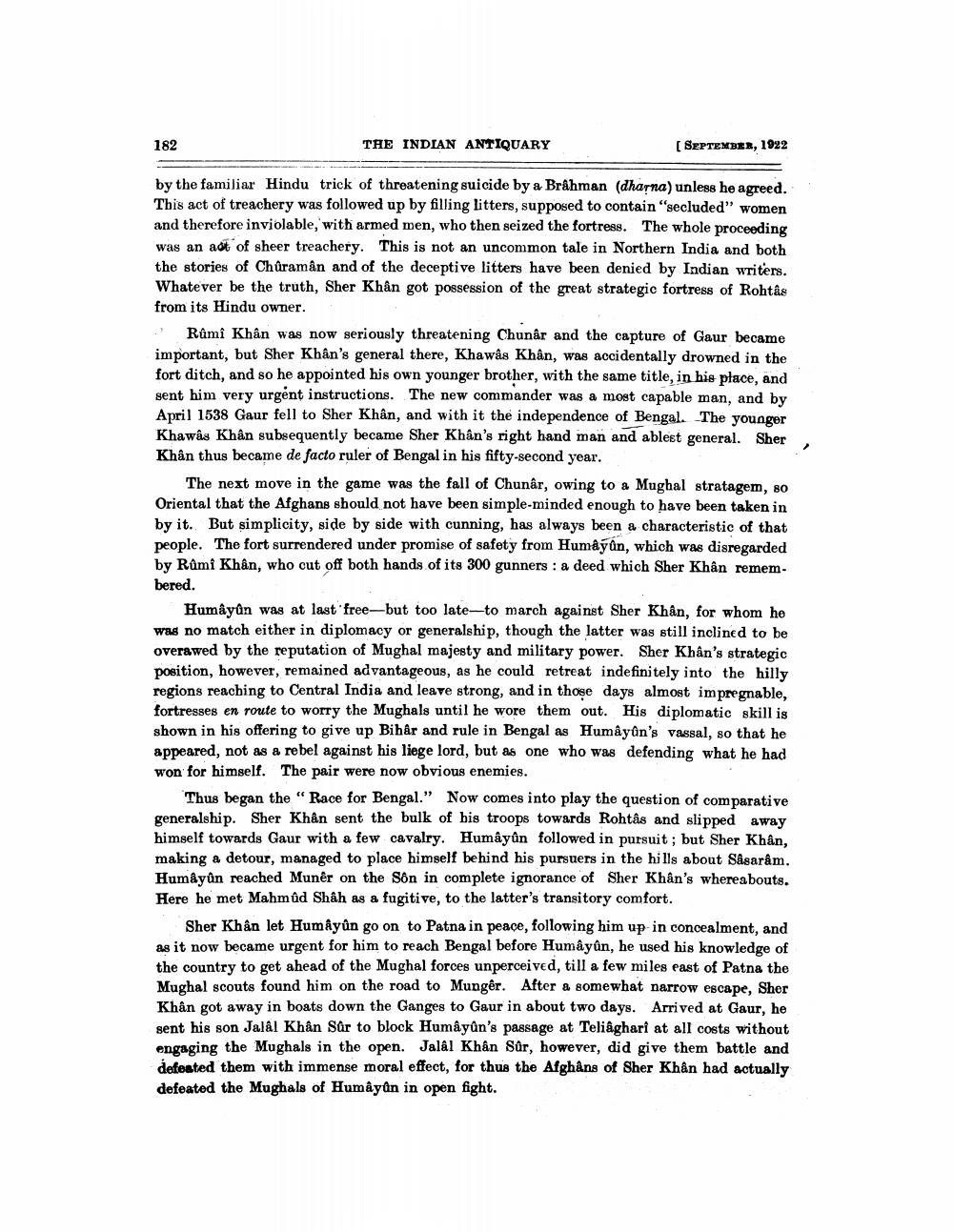________________
182
THE INDIAN ANTIQUARY
[SEPTEMBER, 1922
by the familiar Hindu trick of threatening suicide by a Brahman (dharna) unless he agreed. This act of treachery was followed up by filling litters, supposed to contain "secluded" women and therefore inviolable, with armed men, who then seized the fortress. The whole proceeding was an act of sheer treachery. This is not an uncommon tale in Northern India and both the stories of Chûramân and of the deceptive litters have been denied by Indian writers. Whatever be the truth, Sher Khân got possession of the great strategic fortress of Rohtâs from its Hindu owner.
Rûmî Khân was now seriously threatening Chunâr and the capture of Gaur became important, but Sher Khân's general there, Khawâs Khân, was accidentally drowned in the fort ditch, and so he appointed his own younger brother, with the same title, in his place, and sent him very urgent instructions. The new commander was a most capable man, and by April 1538 Gaur fell to Sher Khân, and with it the independence of Bengal. The younger Khawas Khân subsequently became Sher Khân's right hand man and ablest general. Sher Khân thus became de facto ruler of Bengal in his fifty-second year.
The next move in the game was the fall of Chunâr, owing to a Mughal stratagem, so Oriental that the Afghans should not have been simple-minded enough to have been taken in by it. But simplicity, side by side with cunning, has always been a characteristic of that people. The fort surrendered under promise of safety from Humayun, which was disregarded by Rumi Khân, who cut off both hands of its 300 gunners: a deed which Sher Khân remembered.
Humâyûn was at last free-but too late-to march against Sher Khân, for whom he was no match either in diplomacy or generalship, though the latter was still inclined to be overawed by the reputation of Mughal majesty and military power. Sher Khân's strategic position, however, remained advantageous, as he could retreat indefinitely into the hilly regions reaching to Central India and leave strong, and in those days almost impregnable, fortresses en route to worry the Mughals until he wore them out. His diplomatic skill is shown in his offering to give up Bihâr and rule in Bengal as Humâyûn's vassal, so that he appeared, not as a rebel against his liege lord, but as one who was defending what he had won for himself. The pair were now obvious enemies.
Thus began the "Race for Bengal." Now comes into play the question of comparative generalship. Sher Khân sent the bulk of his troops towards Rohtâs and slipped away himself towards Gaur with a few cavalry. Humâyûn followed in pursuit; but Sher Khân, making a detour, managed to place himself behind his pursuers in the hills about Sâsarâm. Humâyûn reached Munêr on the Sôn in complete ignorance of Sher Khân's whereabouts. Here he met Mahmûd Shâh as a fugitive, to the latter's transitory comfort.
Sher Khân let Humâyûn go on to Patna in peace, following him up in concealment, and as it now became urgent for him to reach Bengal before Humâyûn, he used his knowledge of the country to get ahead of the Mughal forces unperceived, till a few miles east of Patna the Mughal scouts found him on the road to Mungêr. After a somewhat narrow escape, Sher Khân got away in boats down the Ganges to Gaur in about two days. Arrived at Gaur, he sent his son Jalal Khân Sûr to block Humâyûn's passage at Teliâghari at all costs without engaging the Mughals in the open. Jalâl Khân Sûr, however, did give them battle and defeated them with immense moral effect, for thus the Afghâns of Sher Khân had actually defeated the Mughals of Humâyân in open fight.




